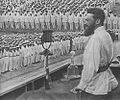| No. | Portrait | Name
(Born-Died) | Term of office | Political Party |
|---|
| Took office | Left office | Time in office |
|---|
| Executive Secretary of the Byelorussian Communist Party |
| 5 | | Vilhelm Knorin
(1890–1939) | 9 August 1920 | 30 December 1922 | 2 years, 143 days | CPB |
| 6 | | Waclaw Bogucki
(1884–1937) | 30 December 1922 | 12 February 1924 | 1 year, 44 days | CPB |
| 7 | | Aleksandr Osatkin-Vladimirsky
(1885–1937) | 12 February 1924 | 29 September 1924 | 199 days | CPB |
| 8 | | Alexander Krinitsky
(1894–1937) | 13 May 1924 | 22 December 1925 | 1 year, 223 days | CPB |
| First Secretary of the Byelorussian Communist Party |
| 9 | | Nikolay Goloded
(1894–1937) | 22 December 1925 | 7 May 1927 | 1 year, 136 days | CPB |
| (5) | | Vilhelm Knorin
(1890–1939) | 7 May 1927 | 4 December 1928 | 211 days | CPB |
| 10 | | Yan Gamarnik
(1894–1937) | 4 December 1928 | 3 January 1930 | 1 year, 30 days | CPB |
| 11 | | Konstantin Gey
(1896–1937) | 3 January 1930 | 18 January 1932 | 2 years, 15 days | CPB |
| 12 | | Nikolay Gikalo
(1897–1938) | 18 January 1932 | 18 March 1937 | 5 years, 59 days | CPB |
| 13 | | Vasily Sharangovich
(1897–1938) | 18 March 1937 | 17 July 1937 | 121 days | CPB |
| – | | Yakov Yakovlev
(1897–1938)
Acting | 17 July 1937 | 8 August 1937 | 22 days | CPB |
| 14 | | Aleksei Volkov
(1890–1942) | 11 August 1937 | 18 June 1938 | 311 days | CPB |
| 15 | | Panteleimon Ponomarenko
(1902–1984) | 18 June 1938 | 7 March 1947 | 8 years, 262 days | CPB |
| 16 | | Nikolai Gusarov
(1905–1985) | 7 March 1947 | 31 May 1950 | 3 years, 85 days | CPB |
| 17 | | Nikolai Patolichev
(1908–1989) | 31 May 1950 | 28 July 1956 | 6 years, 58 days | CPB |
| 18 | | Kirill Mazurov
(1914–1989) | 28 July 1956 | 30 March 1965 | 8 years, 245 days | CPB |
| 19 | | Pyotr Masherov
(1919–1980) | 30 March 1965 | 4 October 1980 † | 15 years, 158 days | CPB |
| – | | Vladimir Brovikov
(1931–1992)
Acting | 4 October 1980 | 16 October 1980 | 12 days | CPB |
| 20 | | Tikhon Kiselyov
(1917–1983) | 16 October 1980 | 11 January 1983 † | 2 years, 117 days | CPB |
| – | | Vladimir Brovikov
(1931–1992)
Acting | 11 January 1983 | 13 January 1983 | 2 days | CPB |
| 21 | | Nikolay Slyunkov
(1929–2022) | 13 January 1983 | 6 February 1987 | 4 years, 24 days | CPB |
| 22 | | Yefrem Sokolov
(1926–2022) | 6 February 1987 | 28 July 1990 [1] | 3 years, 172 days | CPB |
























